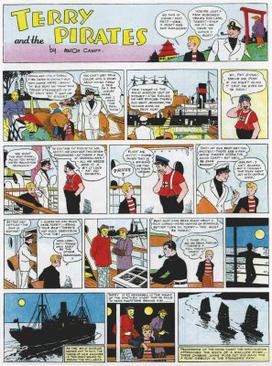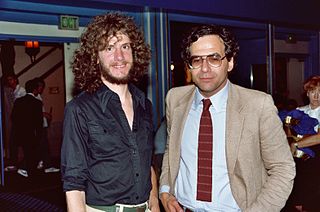Terry and the Pirates is the title of:

Terry and the Pirates is an action-adventure comic strip created by cartoonist Milton Caniff, which originally ran from October 22, 1934, to February 25, 1973. Captain Joseph Patterson, editor for the Chicago Tribune New York News Syndicate, had admired Caniff's work on the children's adventure strip Dickie Dare and hired him to create the new adventure strip, providing Caniff with the title and locale. The Dragon Lady leads the evil pirates; conflict with the pirates was diminished in priority when World War II started.
Terry and the Pirates is a radio serial adapted from the comic strip of the same name created in 1934 by Milton Caniff. With storylines of action, high adventure and foreign intrigue, the popular radio series enthralled listeners from 1937 through 1948. With scripts by Albert Barker, George Lowther and others, the program's directors included Cyril Armbrister, Wylie Adams, and Marty Andrews.

Terry and the Pirates is an American adventure series based on Milton Caniff's comic strip that was telecast from June 26 to November 21, 1953. The syndicated series ran for 18 episodes and was produced by Don Sharpe Enterprises. Canada Dry Ginger Ale was the show's original sponsor.

Milton Arthur Paul Caniff was an American cartoonist known for the Terry and the Pirates and Steve Canyon comic strips.

Steve Canyon is an American adventure comic strip by writer-artist Milton Caniff. Launched shortly after Caniff retired from his previous strip, Terry and the Pirates, Steve Canyon ran from January 13, 1947, until June 4, 1988. It ended shortly after Caniff's death. Caniff won the Reuben Award for the strip in 1971.

George S. Wunder was an American cartoonist best known for his 26 years illustrating the Terry and the Pirates comic strip.
Male Call is an American comic strip series created and drawn by Milton Caniff on a volunteer basis, exclusively for US military publications during World War II. The strip began January 24, 1943. Caniff continued Male Call until seven months after V-J Day, bringing it to a conclusion on March 3, 1946.

Noel Douglas Sickles was an American commercial illustrator and cartoonist, best known for the comic strip Scorchy Smith.

Lee Elias was a British-American comics artist. He was best known for his work on the Black Cat comic book published by Harvey Comics in the 1940s.

Dickie Dare was a comic strip syndicated by AP Newsfeatures. Launched July 31, 1933, it was the first comic strip created by Milton Caniff before he began Terry and the Pirates. The strip ended on October 12, 1957.
Dragon Lady is usually a stereotype of certain East Asian and occasionally South Asian and/or Southeast Asian women as strong, deceitful, domineering, mysterious, and often sexually alluring. Inspired by the characters played by actress Anna May Wong, the term comes from the female villain in the comic strip Terry and the Pirates. It has since been applied to powerful women from certain regions of Asia, as well as a number of Asian and Asian American film actresses. The stereotype has generated a large quantity of sociological literature. "Dragon Lady" is sometimes applied to persons who lived before the term became part of American slang in the 1930s. "Dragon Lady" is one of two main stereotypes used to describe women, the other being "Lotus Blossoms". Lotus Blossoms tend to be the opposite of the Dragon Lady stereotype, having their character being hyper-sexualized and submissive. Dragon Lady is also used to refer to any powerful but prickly woman, usually in a derogatory fashion.

Terry and the Pirates (1940) is the 10th film serial released by Columbia. It is based on the comic strip Terry and the Pirates created by Milton Caniff. In his biography, Meanwhile..., Caniff stated that he hated the serial for changing so much of his comic strip, and that "I saw the first chapter and walked out screaming".

Bruce Gentry was an aviation adventure comic strip by Ray Bailey, distributed by the Post-Hall Syndicate. It debuted March 25, 1945, and by July the strip had expanded to 35 newspapers.
Lai Choi San (meaning Mountain of Wealth) was a Chinese pirate active in the 1920s and 1930s. Her historicity, or at the very least the historicity of most of what is known of her, is disputed since the main source on her life is the 1931 report I Sailed with Pirates by Aleko Lilius, a journalist of dubious repute.
Robert C. Harvey was an American author, critic and cartoonist. He wrote a number of books on the history and theory of cartooning, with special focus on the comic strip. He also worked as a freelance cartoonist.

Sheldon "Shel" Dorf was an American comic book enthusiast and the founder of San Diego Comic-Con International. Dorf was also a freelance artist and graphic designer, who lettered the Steve Canyon comic strip for the last 12 to 14 years of the strip's run.

Dean Mullaney is an American editor, publisher, and designer whose Eclipse Enterprises, founded in 1977, was one of the earliest independent comic-book companies. Eclipse published some of the first graphic novels and was one of the first comics publishers to champion creators' rights. In the 2000s, he established the imprint The Library of American Comics of IDW Publishing to publish hardcover collections of comic strips. Mullaney and his work have received seven Eisner Awards.
Dragon Lady Comics was a comic book shop in Toronto, Canada, owned by John Biernat. Founded in 1978 as a mail order company, Dragon Lady Comics was opened as a store the following year. Dragon Lady closed on 3 February 2012. The comics business reopened nearby on 8 February 2012 as the Comic Book Lounge and Gallery.
William Raphael Louis Dwyer, Jr., known as Bil Dwyer, was an American cartoonist and humorist. He was known for several newspaper comic strips in the 1930s and 1950s, including Dumb Dora and Sandy Hill, as well as a series of humorous books of Southern slang published in the 1970s.













